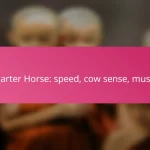Appaloosa horses are celebrated for their striking color patterns and impressive agility, traits that make them stand out in the equestrian world. With a rich heritage linked to Native American culture, particularly the Nez Perce tribe, these horses have been valued companions for work and leisure alike. Their unique appearance and quick reflexes enable them to excel in various performance events and disciplines.

What are the Appaloosa horse color patterns?
Appaloosa horses are known for their distinctive color patterns, which can vary widely among individuals. These patterns not only contribute to their unique appearance but also reflect their heritage and breeding history.
Leopard complex patterns
Leopard complex patterns are characterized by a base coat color with large, irregular spots that can be found all over the horse’s body. These spots can range in color from white to darker shades, creating a striking contrast. Horses with this pattern often have a white coat with dark spots, or vice versa, making them easily recognizable.
Common base colors for leopard complex patterns include bay, chestnut, and black. The presence of the leopard gene can also influence the overall look, leading to variations like the fewspot, where the horse appears nearly solid with only a few spots.
Blanket patterns
Blanket patterns feature a solid-colored horse with a white or light-colored area across the hindquarters, resembling a blanket. This pattern can be accompanied by spots, which may vary in size and distribution. The blanket can be a solid white or have spots that match the horse’s base color.
Blanket patterns are popular among Appaloosa enthusiasts, as they provide a classic look while still showcasing the horse’s unique characteristics. The size and shape of the blanket can differ significantly from one horse to another.
Snowflake patterns
Snowflake patterns consist of a base coat with small, lighter-colored spots scattered across the body, resembling snowflakes. These spots can be white or cream and are often seen on darker base colors like black or bay. The snowflake pattern can create a beautiful effect, especially in sunlight.
Horses with snowflake patterns may also have a mottled skin appearance, particularly around the muzzle and eyes, which adds to their unique charm. This pattern can vary in density, with some horses having very few spots and others being almost entirely covered.
Frosted patterns
Frosted patterns are characterized by a base coat that appears to be dusted with lighter spots, giving a frosty appearance. This pattern is often seen on Appaloosas with darker coats, where the lighter spots can create a shimmering effect. The frosted look can be subtle or pronounced, depending on the individual horse.
Frosted patterns can also be accompanied by a mottled skin texture, particularly around the eyes and muzzle, enhancing the horse’s distinctive look. This pattern is less common than others but is highly sought after for its unique aesthetic.
Spotted patterns
Spotted patterns are defined by the presence of spots on a solid-colored coat. These spots can vary in size and color, creating a diverse range of appearances. The spots can be small and numerous or large and few, depending on the horse.
Spotted patterns can be found in various base colors, including chestnut, black, and gray. The contrast between the base color and the spots can be quite striking, making these horses stand out in any setting. Spot patterns can also change as the horse ages, adding to their dynamic appearance.

How agile are Appaloosa horses?
Appaloosa horses are known for their impressive agility, making them well-suited for various equestrian activities. Their quick reflexes and nimble movements allow them to excel in performance events and adapt to different disciplines.
High agility in performance
The agility of Appaloosa horses is evident in their ability to navigate obstacles and perform intricate maneuvers. They are often seen in competitive events such as barrel racing and cutting, where quick turns and speed are essential. Their strong hindquarters contribute to powerful bursts of speed, enhancing their performance capabilities.
Versatile in various disciplines
Appaloosas are versatile horses, thriving in multiple disciplines beyond traditional western riding. They are commonly used in dressage, eventing, and trail riding, showcasing their adaptability. This versatility makes them popular among riders who participate in diverse equestrian activities.
Strong endurance capabilities
In addition to their agility, Appaloosas possess strong endurance, allowing them to maintain speed over longer distances. This quality is particularly beneficial in endurance riding competitions, where horses may cover significant mileage. Their stamina, combined with agility, makes them well-rounded partners for both recreational and competitive riders.

What is the heritage of the Appaloosa horse?
The Appaloosa horse has a rich heritage rooted in Native American culture, particularly among the Nez Perce tribe. This breed is known for its distinctive color patterns and agility, which have made it a valuable companion for both work and leisure throughout history.
Native American origins
The Appaloosa horse traces its origins back to the Nez Perce tribe in the Pacific Northwest of the United States. These horses were bred for their versatility, strength, and unique spotted coats, which were highly valued by the tribe. The Nez Perce utilized these horses for hunting, warfare, and transportation, integrating them deeply into their way of life.
As European settlers arrived, they recognized the Appaloosa’s exceptional qualities, leading to increased interest and trade. The breed’s distinct appearance and capabilities made it sought after beyond its native region.
Historical significance in the Nez Perce tribe
The Appaloosa horse holds significant cultural importance for the Nez Perce tribe. It symbolizes their heritage and connection to the land, as well as their skills in horsemanship. The tribe developed a unique breeding program that emphasized traits such as endurance, speed, and agility, which were essential for their nomadic lifestyle.
During the Nez Perce War in the late 1800s, these horses played a crucial role in the tribe’s resistance against U.S. government forces. The breed’s agility and stamina allowed the Nez Perce to evade capture, showcasing the Appaloosa’s importance in their struggle for autonomy.
Development through selective breeding
The Appaloosa horse’s development involved selective breeding practices that emphasized desirable traits. Breeders focused on maintaining the horse’s distinctive coat patterns, which can include spots, blankets, and roans. This attention to aesthetics, combined with functional qualities, has helped preserve the breed’s unique identity.
In the 20th century, efforts to standardize the breed led to the establishment of the Appaloosa Horse Club in the United States. This organization promotes the breed and ensures the continuation of its heritage through responsible breeding practices. Today, Appaloosas are recognized for their versatility in various equestrian disciplines, from rodeo to dressage.

What are the key characteristics of Appaloosa horses?
Appaloosa horses are known for their unique coat patterns, strong athletic build, and intelligent temperament. These traits make them versatile and popular among riders for various disciplines, from Western riding to dressage.
Distinctive coat patterns
One of the most striking features of Appaloosa horses is their distinctive coat patterns, which can include spots, stripes, and mottled skin. Common patterns include the leopard, blanket, and snowflake, each offering a unique visual appeal. The coat colors can range from white to black, chestnut, and bay, often combined with these patterns.
These unique patterns are not just for aesthetics; they are a result of specific genetic traits. Breeders often select for these patterns, leading to a wide variety of appearances within the breed.
Strong build and athleticism
Appaloosa horses possess a strong build, characterized by a muscular body and sturdy legs, which contribute to their agility and endurance. They typically stand between 14.2 to 16 hands high, making them suitable for various riders. Their physical strength allows them to excel in activities such as barrel racing, jumping, and trail riding.
In addition to their strength, Appaloosas are known for their agility. They can quickly change direction and speed, which is essential in competitive events. This athleticism makes them a favorite among riders looking for a reliable and capable partner.
Intelligent and trainable temperament
Appaloosa horses are recognized for their intelligence and willingness to learn, which makes them highly trainable. They often form strong bonds with their handlers, responding well to positive reinforcement techniques. This temperament allows them to adapt to various training methods and disciplines.
However, their intelligence can also lead to stubbornness if not managed properly. Consistent training and clear communication are essential to harness their potential effectively. Riders should focus on building trust and respect to ensure a successful partnership.

What are the best practices for caring for Appaloosa horses?
Caring for Appaloosa horses involves providing proper nutrition, regular exercise, and training tailored to their unique characteristics. These practices ensure their health, agility, and overall well-being.
Proper nutrition and diet
Appaloosa horses require a balanced diet that supports their active lifestyle. High-quality hay, grains, and supplements rich in vitamins and minerals are essential for maintaining their energy levels and coat condition.
Consider feeding them a mix of forage and concentrates, adjusting portions based on their age, weight, and activity level. Regularly monitor their body condition to avoid obesity or malnutrition.
Regular exercise and training
Regular exercise is crucial for Appaloosas to maintain their agility and fitness. Aim for at least 30 minutes of moderate exercise several times a week, incorporating activities like riding, lunging, or free running.
Training should focus on building their skills and confidence, utilizing varied exercises to keep them engaged. Consistency is key; establish a routine that balances work and rest to prevent injuries and promote a strong bond between horse and handler.


